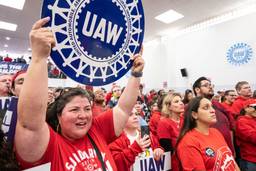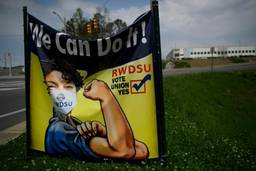The answer is yes, according to a new Gallup poll
Labor groups might have the public’s support amid ongoing disputes, but a recent survey says union employees in America aren’t all that happy in the workplace.
A Gallup poll published in mid-March found union workers in the private and public sectors are less satisfied than their non-union counterparts.
Among the key findings, more union workers viewed their supervisors as “bosses” rather than “partners,” and were more likely to work under management that isn’t as “open and trusting.” The report also goes on to suggest that union workers “may be less engaged with their jobs” based on the relatively lower well-being scores.
The findings are in contrast to previous studies that have found union membership as a contributor to life satisfaction. But critics say the results aren’t surprising given the nature of union relationships with management, and argue that union members are more invested in their jobs, not less.
While the results were based on interviews from last year, the survey provides an interesting backdrop as public sectors workers in particular are increasingly growing frustrated by efforts to submit to concessions and limit bargaining rights in the face of government budget deficits.
The results are taken from Gallup’s own “Work Environment Index,” based on four criteria that include overall employees’ job satisfaction, ability to utilize skills, how their manager treats them, and whether workers are supervised under favorable conditions.
The survey interviewed union and non-union employees in businesses and government, including federal, state and local workers. Among the findings, nonunion members across all sectors rated higher on the Work Environment Index than their unionized cohorts.
The survey was conducted throughout the entire 2010 as part of the Gallup Healthways Well-Being Index, a quality of life measurement that started in January 2008.
The responses were taken before more recent developments in the public sector as states and lawmakers have waged campaigns to reduce unions’ pay, benefits and eliminate collective representation.
But the survey did offer a prelude to many civil servants who are increasingly at odds with various anti-union legislation proposals. With murmurs of a government shutdown this week, federal union employees ranked lowest on the Index with 35.6 points, which was 9.4 points lower than non-union federal workers. Private sector union members (41.9) and non-union members (52.1) saw the largest difference, with 10.2 points in workplace satisfaction.
Union workers in government also reported they were more likely to see their supervisors as bosses compared to non-union members. The trend reflected employees in all three government sectors, who reported that their managers were less likely to facilitate a trusting relationship in the workplace.
While Gallup has been measuring monthly quality of life surveys via the more general Well-Being index for three years, it appears that this is the first time the organization has published workplace attitudes comparing union and non-union members.
As a result, it difficult to determine if the results are based on the recent events or if the results are simply the natural result of institutional dynamics. Gallup notes that it isn’t clear if workers who view supervisors more antagonistically tend to gravitate towards union jobs, or if having a bargaining unit in the workplace changes the dynamics of the employee-management relationship.
Benjamin Radcliff, a political science professor at University of Notre Dame, doesn’t dismiss the idea that the lower results for union workers could be attributed to the current labor strife. But he also says readers shouldn’t be surprised by the findings because employees and their supervisors are already in an adversarial relationship. People who join unions are inherently less satisfied since they have higher expectations to improve working conditions than non-members, he said.
“Union contracts create official, procedural relationships between worker and employer that make explicit this tension, that a non-union workplace tries to obscure with ‘we are a family” type talk,’” wrote Radcliff in an e-mail to In These Times.
Radcliff was one the authors in a study published last year in Social Indicators Research, which that found that people who live in counties with higher union density rates were happier - for union members and non-members alike.
He adds that unionized workers would tend to trust their own labor network – an independent source of authority - over management. He says that may explain the why union members ranked lower when asked whether their supervisors create an “open and trusting work environment.”
He also called Gallup’s suggestion that union workers as less engaged as “dead wrong.” It’s actually quite the opposite.
“Members of unions tend to have a greater sense of ‘voice,’” he writes. “In general, the union structure should encourage more, not less connection or ‘engagement’ with one’s job, since one is represented by a union in grievances with the employer, generally earns a higher wage and gets better benefits, and so on.”
It could be that union members are perpetually fighting for better conditions, or that card-carrying workers are now feeling the emotional toll more from the on-going labor disputes. One thing is for sure is for sure: unions are fully engaged in their own workplaces now, perhaps more than ever.

I hope you found this article important. Before you leave, I want to ask you to consider supporting our work with a donation. In These Times needs readers like you to help sustain our mission. We don’t depend on—or want—corporate advertising or deep-pocketed billionaires to fund our journalism. We’re supported by you, the reader, so we can focus on covering the issues that matter most to the progressive movement without fear or compromise.
Our work isn’t hidden behind a paywall because of people like you who support our journalism. We want to keep it that way. If you value the work we do and the movements we cover, please consider donating to In These Times.






